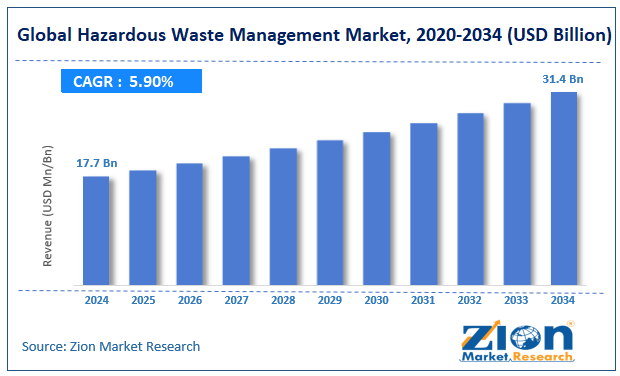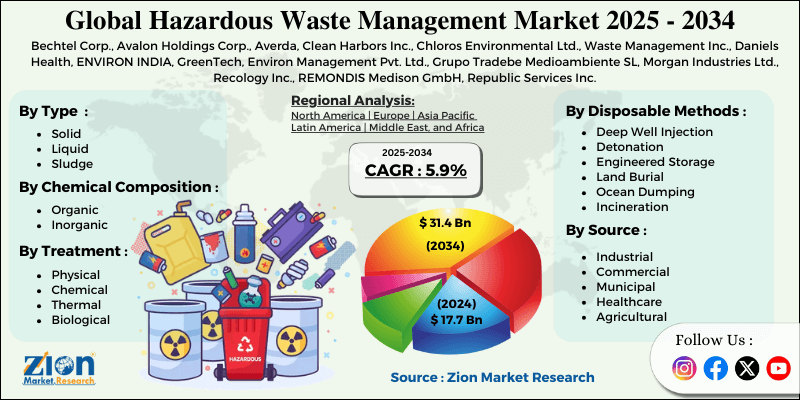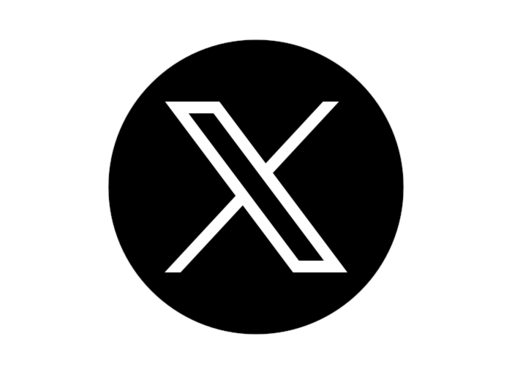Hazardous Waste Management Market Size, Share, Trends, Growth and Forecast 2034

Hazardous Waste Management Market By Type (Solid, Liquid, and Sludge), By Treatment (Physical, Chemical, Thermal, and Biological), By Disposable Method (Deep Well Injection, Detonation, Engineered Storage, Land Burial, Ocean Dumping, and Incineration), By Source (Industrial, Commercial, Municipal, Healthcare, and Agricultural), By Chemical Composition (Organic and Inorganic), and By Region - Global and Regional Industry Overview, Market Intelligence, Comprehensive Analysis, Historical Data, and Forecasts 2025 - 2034
| Market Size in 2024 | Market Forecast in 2034 | CAGR (in %) | Base Year |
|---|---|---|---|
| USD 17.7 Billion | USD 31.4 Billion | 5.9% | 2024 |
Hazardous Waste Management Industry Prospective:
The global hazardous waste management market size was worth around USD 17.7 billion in 2024 and is predicted to grow to around USD 31.4 billion by 2034, with a compound annual growth rate (CAGR) of roughly 5.9% between 2025 and 2034.
Hazardous Waste Management Market: Overview
The collection, treatment, transportation, disposal, and recycling of garbage that poses a serious risk to human health and the environment are all part of the intricate process of hazardous waste management. Many people think this is a serious environmental issue. Every year, humans produce trillions of pounds of waste, but there are no longer enough places to dispose of it. Governments are advocating for appropriate trash management, particularly for garbage that is extremely dangerous to human life.
Key Insights
- As per the analysis shared by our research analyst, the global hazardous waste management market is estimated to grow annually at a CAGR of around 5.9% over the forecast period (2025-2034).
- In terms of revenue, the global hazardous waste management market size was valued at around USD 17.7 billion in 2024 and is projected to reach USD 31.4 billion by 2034.
- The increasingly stringent regulation is expected to drive the hazardous waste management market over the forecast period.
- Based on the type, the solid segment is expected to hold the largest market share over the forecast period.
- Based on the treatment, the physical segment is expected to dominate the market expansion over the projected period.
- Based on the disposable method, the detonation segment is expected to dominate the market during the forecast period.
- Based on the source, the industrial segment is expected to hold the largest market share over the forecast period.
- Based on the chemical composition, the organic segment is expected to capture a strong market share over the forecast period.
- Based on region, North America is expected to dominate the market during the forecast period.
Hazardous Waste Management Market: Growth Drivers
Increasing industrialization drives market growth
The rapid expansion of industrial activity worldwide drives the hazardous waste management market. The demand for waste management solutions rises due to the expansion in the mining, manufacturing, chemical processing, healthcare, and energy sectors. For instance, China's waste production has tripled since the 1990s owing to China's rising urbanization.
According to figures from China's National Bureau of Statistics, about 66.2% of the country's population lived in urban areas in 2023. Similarly, as per the statistics from the International Energy Agency, approximately 270 million people will be added 2040 to the Indian economy. Thus, the aforementioned stats drive the market growth.
Hazardous Waste Management Market: Restraints
High cost of hazardous waste treatment & disposal hinders market growth
The high cost of processing and disposing of hazardous waste is one of the major obstacles impeding the hazardous waste management industry's growth.
The manufacturing organization that produces hazardous waste is subject to stringent regulations that require advanced technologies and specialized management, which increases operational costs. Incineration, plasma gasification, bioremediation, and chemical neutralization require costly and specialized facilities.
The costs are also increased by the need for leachate collecting systems, impermeable liners, and monitoring techniques for the safe disposal of hazardous waste. Furthermore, to prevent contamination and accidents, managing hazardous waste requires highly qualified personnel and strict safety protocols.
Hazardous Waste Management Market: Opportunities
Increasing funding offers a lucrative opportunity for market growth
The hazardous waste management market is driven by growing funding. For instance, in October 2024, the Global Framework on Chemicals issued its first request for projects aimed at the safe and sustainable waste management and chemicals, a year after it was adopted in Bonn.
In some of the world's most impoverished nations, the chosen projects are anticipated to focus on environmentally friendly and sustainable solutions as well as to coordinate efforts to prevent and reduce harm from trash and chemicals.
To promote transformative change to control and limit harm from chemicals and waste, as well as to safeguard the environment and human health, especially vulnerable groups and workers, a selection of projects will receive between $300,000 and $800,000 for a maximum of three years.
Medium-sized projects that support national policies and regulations, advance solutions along the value chain, strengthen national and regional capacities on chemicals and waste management, and collaborate with ministries, regional centers, health networks, major industry sectors, investment and development banks, small businesses, and civil society are the fund's target.
Hazardous Waste Management Market: Challenges
Lack of infrastructure & skilled workforce in emerging economies poses a major challenge to market expansion
Due to a lack of qualified personnel and poor infrastructure, the hazardous waste management market in emerging economies is confronted with major obstacles. These elements create threats to the environment and human health by limiting the effective collection, processing, and disposal of hazardous waste.
Hazardous Waste Management Market: Report Scope
| Report Attributes | Report Details |
|---|---|
| Report Name | Hazardous Waste Management Market |
| Market Size in 2024 | USD 17.7 Billion |
| Market Forecast in 2034 | USD 31.4 Billion |
| Growth Rate | CAGR of 5.9% |
| Number of Pages | 214 |
| Key Companies Covered | Bechtel Corp., Avalon Holdings Corp., Averda, Clean Harbors Inc., Chloros Environmental Ltd., Waste Management Inc., Daniels Health, ENVIRON INDIA, GreenTech, Environ Management Pvt. Ltd., Grupo Tradebe Medioambiente SL, Morgan Industries Ltd., Recology Inc., REMONDIS Medison GmbH, Republic Services Inc., Seche Environnement SA, Sharps Compliance Corp., SMS Envocare Ltd., Veolia Environment SA, Waste Connections Inc., and others. |
| Segments Covered | By Type, By Treatment, By Disposable Methods, By Source, By Chemical Composition, and By Region |
| Regions Covered | North America, Europe, Asia Pacific (APAC), Latin America, Middle East, and Africa (MEA) |
| Base Year | 2024 |
| Historical Year | 2019 to 2023 |
| Forecast Year | 2025 - 2034 |
| Customization Scope | Avail customized purchase options to meet your exact research needs. Request For Customization |
Hazardous Waste Management Market: Segmentation
The global hazardous waste management industry is segmented based on type, treatment, disposable methods, source, chemical composition, and region.
Based on the type, the global hazardous waste management market is bifurcated into solid, liquid, and sludge. The solid segment is expected to hold the largest market share over the forecast period because of increased urbanization and industrial activity, which produces a lot of solid hazardous waste. The market is driven by the increasing requirement for recycling and safe disposal techniques to lessen the impact on the environment.
Furthermore, corporations and governments are placing greater focus on environmentally friendly waste management techniques, which opens up new avenues for the creation of creative solutions.
Based on the treatment, the global hazardous waste management industry is bifurcated into physical, chemical, thermal, and biological. The physical segment is expected to dominate the market expansion over the projected period due to its efficacy in eliminating contaminants and the increasing need for cost-effective and efficient hazardous waste management technologies. This approach is particularly common in industries requiring high levels of physical separation. The growing need for affordable and energy-efficient solutions in handling hazardous waste is also accelerating the use of physical treatment technologies.
Based on the disposable methods, the global hazardous waste management market is bifurcated into deep well injection, detonation, engineered storage, land burial, ocean dumping, and incineration. The detonation segment is expected to dominate the market during the forecast period. Regulations requiring safe and ecologically responsible disposal methods are driving this disposal method. Deep well injection is a common and effective waste disposal method since it enables enterprises to handle massive amounts of hazardous liquid waste.
Based on the source, the global hazardous waste management industry is bifurcated into industrial, commercial, municipal, healthcare, and agricultural. The industrial segment is expected to hold the largest market share over the forecast period as industrial operations generate enormous amounts of hazardous waste.
Increasing industrial production and the necessity for compliance with environmental legislation are increasing the demand for waste management systems. To reduce their environmental impact, industries are also embracing green and sustainable practices more and more, which is driving the development of creative waste treatment and recycling solutions.
Based on the chemical composition, the global hazardous waste management market is bifurcated into organic and inorganic. The organic segment is expected to capture a strong market share over the forecast period. The segment growth is spurred by the expanding use of dangerous chemicals in sectors like industry, agriculture, and pharmaceuticals.
Demand in the market is driven by the requirement for organic compounds to be disposed of and recycled safely. The need for efficient waste management solutions is also fueled by the growing public and regulatory focus on lessening the negative environmental effects of chemical contaminants.
Hazardous Waste Management Market: Regional Analysis
North America dominates the market over the projected period
North America is expected to dominate the global hazardous waste management market. Growing industrialization, energy efficiency laws, and the need for sustainable solutions in sectors like HVAC, organic, and inorganic are driving the region's market expansion. The market is growing as a result of significant investments in modern infrastructure and renewable energy.
Besides, the Asia Pacific is expected to grow at the highest CAGR over the forecast period. The region's market is expanding because of growing industrialization, energy efficiency regulations, and the demand for sustainable solutions in industries like HVAC, organic, and inorganic. Due to large expenditures on renewable energy and modern infrastructure, the market is expanding.
Hazardous Waste Management Market: Competitive Analysis
The global hazardous waste management market is dominated by players like:
- Bechtel Corp.
- Avalon Holdings Corp.
- Averda
- Clean Harbors Inc.
- Chloros Environmental Ltd.
- Waste Management Inc.
- Daniels Health
- ENVIRON INDIA
- GreenTech
- Environ Management Pvt. Ltd.
- Grupo Tradebe Medioambiente SL
- Morgan Industries Ltd.
- Recology Inc.
- REMONDIS Medison GmbH
- Republic Services Inc.
- Seche Environnement SA
- Sharps Compliance Corp.
- SMS Envocare Ltd.
- Veolia Environment SA
- Waste Connections Inc.
The global hazardous waste management market is segmented as follows:
By Type
- Solid
- Liquid
- Sludge
By Treatment
- Physical
- Chemical
- Thermal
- Biologica
By Disposable Methods
- Deep Well Injection
- Detonation
- Engineered Storage
- Land Burial
- Ocean Dumping
- Incineration
By Source
- Industrial
- Commercial
- Municipal
- Healthcare
- Agricultural
By Chemical Composition
- Organic
- Inorganic
By Region
-
North America
- The U.S.
- Canada
- Europe
- France
- The UK
- Spain
- Germany
- Italy
- Rest of Europe
- Asia Pacific
- China
- Japan
- India
- South Korea
- Southeast Asia
- Rest of Asia Pacific
- Latin America
- Brazil
- Mexico
- Rest of Latin America
- Middle East & Africa
- GCC
- South Africa
- Rest of Middle East & Africa
Table Of Content
Methodology
FrequentlyAsked Questions
The collection, treatment, transportation, disposal, and recycling of garbage that poses a serious risk to human health and the environment are all part of the intricate process of hazardous waste management.
The hazardous waste management market is driven by several factors, including the growing urbanization and industrialization, growing focus towards green environment, rising collaboration, and others.
According to the report, the global hazardous waste management market size was worth around USD 17.7 billion in 2024 and is predicted to grow to around USD 31.4 billion by 2034.
The global hazardous waste management market is expected to grow at a CAGR of 5.9% during the forecast period.
The global hazardous waste management market growth is expected to be driven by North America. It is currently the world’s highest revenue-generating market due to the growing shift towards a green environment, and stringent regulations.
The global hazardous waste management market is dominated by players like Bechtel Corp., Avalon Holdings Corp., Averda, Clean Harbors Inc., Chloros Environmental Ltd., Waste Management Inc., Daniels Health, ENVIRON INDIA, GreenTech, Environ Management Pvt. Ltd., Grupo Tradebe Medioambiente SL, Morgan Industries Ltd., Recology Inc., REMONDIS Medison GmbH, Republic Services Inc., Seche Environnement SA, Sharps Compliance Corp., SMS Envocare Ltd., Veolia Environment SA, and Waste Connections Inc., among others.
The hazardous waste management market report covers the geographical market along with a comprehensive competitive landscape analysis. It also includes cash flow analysis, profit ratio analysis, market basket analysis, market attractiveness analysis, sentiment analysis, PESTLE analysis, trend analysis, SWOT analysis, trade area analysis, demand & supply analysis, Porter’s five forces analysis, and value chain analysis.
HappyClients
Zion Market Research
Tel: +1 (302) 444-0166
USA/Canada Toll Free No.+1 (855) 465-4651
3rd Floor,
Mrunal Paradise, Opp Maharaja Hotel,
Pimple Gurav, Pune 411061,
Maharashtra, India
Phone No +91 7768 006 007, +91 7768 006 008
US OFFICE NO +1 (302) 444-0166
US/CAN TOLL FREE +1 (855) 465-4651
Email: sales@zionmarketresearch.com
We have secured system to process your transaction.
Our support available to help you 24 hours a day, five days a week.
Monday - Friday: 9AM - 6PM
Saturday - Sunday: Closed







